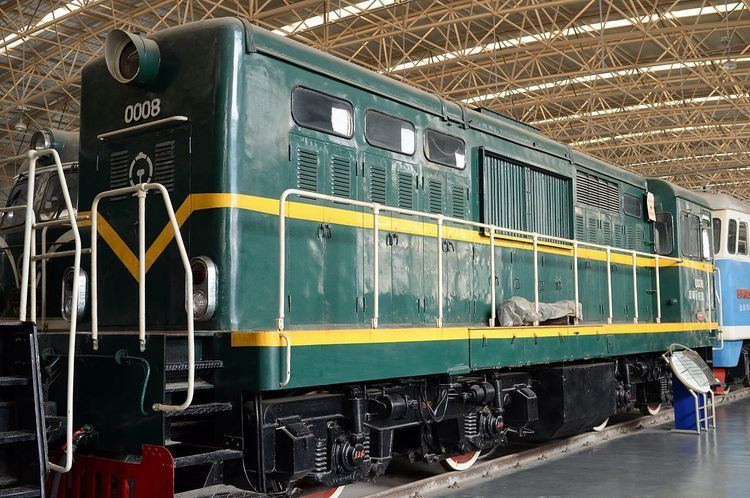Power type Diesel-hydraulic | UIC class B'B' | |
 | ||
Builder DFH2, DFH5, DFH6, DFH7 Ziyang locomotive worksDFH2, DFH5, DFH21 Sifang locomotive works Build date DFH2 1973DFH5 1976-1988DFH6 1981DFH7 1988DFH21 1977 (prototype), 1982 Total produced DFH2 ?DFH5 >500DFH6 1DFH7 4DFH21 >29 Gauge 1,435 mm (4 ft 8 ⁄2 in)DFH21 1,000 mm (3 ft 3 ⁄8 in) | ||
The China Railways "Dongfang Hong" diesel-hydraulic locomotive classes DFH2, DFH5, DFH6 and DFH7 built from the 1970s to 1990s were all used as shunters on the Chinese railway network.
Contents
The use of diesel-hydraulic shunters has fallen out of favour on the Chinese rail network, with diesel-electric locomotives being used, however diesel-hydraulic machines continued to be produced for industrial railways - mainly the China Railways GK classes.
The DFH21 class is a meter gauge version of the DFH2, and was used on the Yunnan–Vietnam Railway for both passenger and freight services; the same machines are used on the Vietnam Railways where they are known as the D10H.
DFH2
The DHF2 was originally designed by Sifang locomotive works in 1966 as a passenger locomotive of rated power 1,470 kW (1,970 hp), the design did not enter mass production, but in 1973 the design was changed at Ziyang locomotive works to a 650 kW (870 hp) power locomotive of top speed 62 km/h (39 mph).
The mass was 60 t (59.1 long tons; 66.1 short tons) and starting tractive effort 192 kN (43,000 lbf). The locomotive used a 12V180ZL engine and SF2010 transmission.
DFH5
In comparison to the DFH2 type a number of changes were made for the DFH5; a twin speed transmission allowing a higher topspeed when running without a heavy load was included, the mass was increased to improve traction.
The DFH5 class was produced in large quantities, the engine was a 12V180ZJ and transmission ZJ2011, producing 278 kN (62,000 lbf) of tractive effort with a mass of 86 t (84.6 long tons; 94.8 short tons) and with a top speed of 40 km/h (25 mph). A higher speed was available with a limit of 80 km/h (50 mph) and tractive effort reduced to approximately half.
Variants were produced introduced 1985, with modififactions to improve reliability and performance; the DFH5B and DFH5C, in both the rated power was increased to 920 kW (1,230 hp), and the mass by 4 t (3.9 long tons; 4.4 short tons). DFH5C was produced for operations in metalworks.
DFH6
One example was produced for shunting in the Chinese port of Huangpu District, Shanghai.
DFH7
Four units produced for shunting in mines and industrial environments.
DFH21
Locomotives similar in design to the DFH2 type but built to meter gauge and used as universal locomotives. The locomotives were used on the Kunming metre gauge railway, including passenger services.
As of 2012, Kunming rail fans report that DFH21 locos are still used to haul a few passenger trains a day along the metre gauge tracks from Kunming North Railway Station to several nearby stations. In 2014 they still drive these trains.
30 of the locomotives are also used by Vietnam Railways where they are known as the D10H, in 2005 the Vietnam railways had 20 units operational. In 2009 ten of the engines had Caterpillar Inc. 3512B engines fitted as replacements.
Preserved locomotivess
DFH2 0008 and DFH5 0001 are both preserved at the Beijing China Railway Museum.
